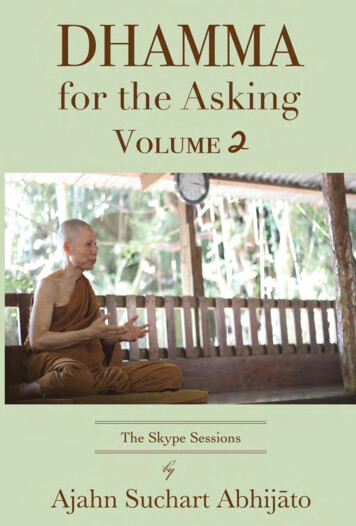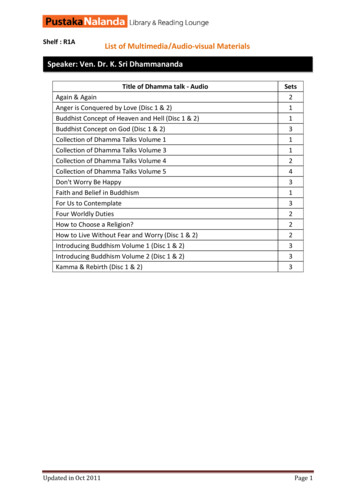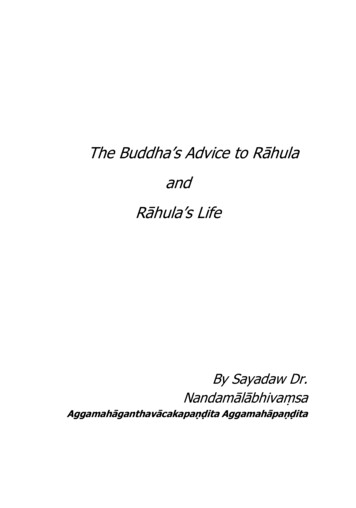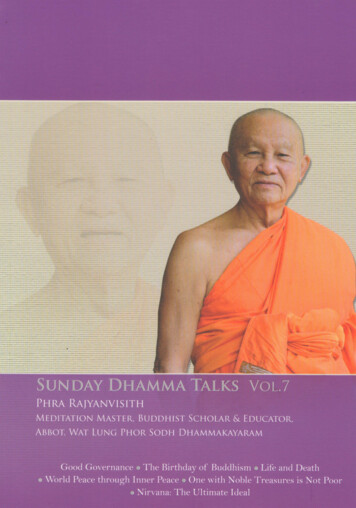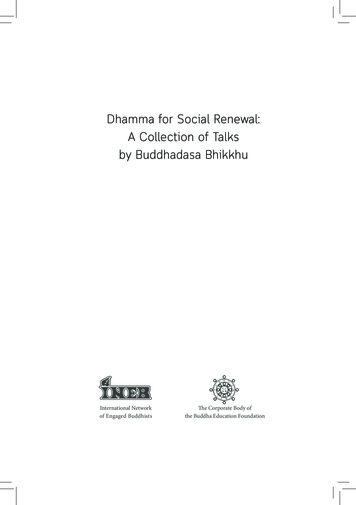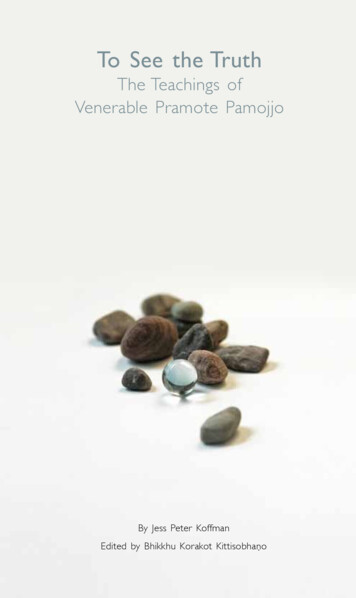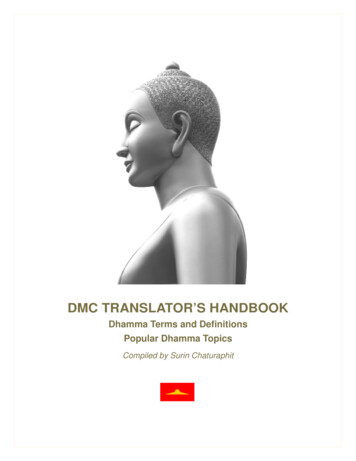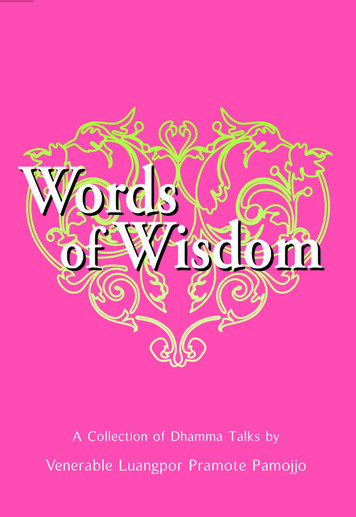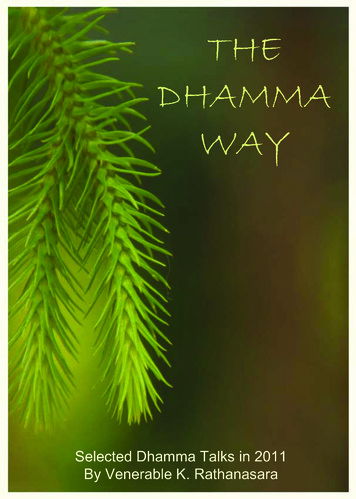
Transcription
“The Gift of Dhamma Excels All Other Gifts”— The Lord Buddha
Mae CheeHerJourney to SpiritualAwakening and EnlightenmentCompiled from Thai sources & written byBhikkhu Dick SīlaratanoA Forest Dhamma Publication
Mae Chee KaewA Forest Dhamma Publication / April 2012All commercial rights reserved. 2012 Bhikkhu Dick SīlaratanoDhamma should not be sold like goods in the market place. Permission to reproducethis publication in any way for free distribution, as a gift of Dhamma, is herebygranted and no further permission need be obtained. Reproduction in any way forcommercial gain is strictly prohibited.Cover and interior design by Melita Halim.Set in Centaur MT Std and Present LT Std.ISBN 978-611-90205-0-4Printed in Thailand by:Silpa Siam Packaging and Printing Co., Ltd.silpa@ksc.th.comTel. (662) 444-3351-9Published by:Forest Dhamma BooksBaan Taad Forest MonasteryUdon Thani 41000, Thailandfdbooks@hotmail.comwww.ForestDhamma.org
ContentsPreface Introduction 913Part One — Blessing Moonstone Pearls Fearless Warrior Spirit Blessing of a Lifetime The Mulberry Grove Immersed in Endless Work Little Kaew 233341505864Part Two — RenunciationLeaving It All Behind Reclaiming Lost Treasure Stirring up a Hornet’s Nest Simply Fetching Water Through the Access Gate The Wild Boar Ghosts of the Mountain 7580879297104109
Nok Kraba Cave Failings of the Spirit Body Contemplation Ideal Buddhist Nun Pilgrimage 116123129135141Part Three — EssenceIntersecting Karmic Paths A Portent of Dhamma The Corpse Within Spontaneous Awareness Luminous Essence Phayom in Full Bloom 151161172180187193Part Four — PurityRiver and Ocean Unstinting Gratitude Lifelong Commitment Pureness of Heart Epilogue Collected Teachings About the Author 203209215219227231243
PrefaceWhile I was living at Nakamnoi Forest Monastery in 2007, theabbot, Ajaan Intawai Santussako, asked me to translate a biographical sketch of Mae Chee Kaew from Thai into English, which heintended to publish in both languages. Although the sketch he gaveme was rather brief, Ajaan Intawai graciously made available all previous writings about Mae Chee Kaew’s life that he had collected.After translating the shortened version of her life into English, Idecided to write a complete account based on more extensive research into the events that shaped her life and marked each step onher path to enlightenment. Nakamnoi Forest Monastery provided mewith a calm and supportive environment in which to work, and themonks there provided valuable research assistance. Mae Chee Kaew’scollected teachings, excerpts of which are quoted at the beginningof each chapter, presented a special challenge as most of them wererecorded in her native Phu Tai dialect. I am indebted to those ethnicPhu Tai monks who helped me to decipher their meaning.This book would not have been completed without the dedicated effort of many friends and helpers. My gratitude to them isimmense. In particular, I would like to thank my longtime copy-
10Mae Chee Kaeweditor, Swe Thant, for deftly smoothing over the rough edges ofthe first draft and helping to set the general tone of the narrative.Rachel Claveau then did a masterful job of trimming down superfluous language and improving the grammatical structure. Rachel alsourged me to clarify many unclear or difficult passages to establishprecisely the intended meaning. Special thanks go to Mae Chee MelitaHalim, who single-handedly created the book’s front and back coverdesigns, the interior design and all of the pencil drawings. She workedtirelessly for many months in difficult circumstances to prepare themanuscript for publication. I feel blessed to have a generous and enthusiastic publisher, Silpa Siam Packaging and Printing Co., Ltd.,who not only facilitated the publication, but also helped to solicitcontributions to fund the cost of printing. Without the generosityof many dedicated donors, it would not have been possible to printthis book and make it available for free distribution. Their namesare too numerous to mention, but each one of them deserves ourheartfelt appreciation. And finally, a hearty thank you to ForestDhamma Books, a worldwide network of friends, for the time andeffort they volunteered in support of this project.
“When I went to the monastery as a younggirl, I had to be accompanied by my parents,and I wasn’t allowed to mingle with the monks.While listening to the monks discuss Dhamma,I sat way in the back, just within earshot. Thevenerable meditation master taught us how topay homage to the Buddha and how to praisehis virtues with chanting. He encouraged us toradiate loving kindness to all living beings, andto always be open-hearted and generous. Hetold us that no matter how generous we wereas lay supporters, the virtue of that generositycould not compare with the virtue of ordainingas a white-robed nun and earnestly practicingthe way to end all suffering. That messagealways remained close to my heart.”— Mae Chee Kaew
IntroductionThis book presents the life and the practice ofa woman whoreached the pinnacle of Buddhist practice in her lifetime. She wasknown as Mae Chee Kaew. Mae Chee Kaew felt the calling to aspiritual life at an early age. Blessed as a girl with the good fortuneto meet some of the most renowned meditation masters of her era,she took their teachings on meditation to heart and, with youthful enthusiasm, earnestly put them into practice. Due to a favorabledisposition, she soon developed into a child prodigy, skilled in theart of samādhi meditation. Her mind easily became absorbed in deepconcentration for many hours, and was witness to many strange andwonderful occurrences.When familial circumstances intervened to prevent her from undertaking a religious vocation, she bided her time patiently, waitingto take advantage of the earliest opportunity. After twenty years ofunsatisfactory marriage, a door finally opened for Mae Chee Kaewand she stepped through, entering a life of renunciation. As a nun,she spent many years living and practicing with teachers of greatrenown. They often praised her for her extraordinary skills in meditation, especially her adeptness with psychic phenomena. Very few
14Mae Chee Kaewof them could equal her prowess in that field of perception. Moresignificantly, however, she succeeded in overcoming her attachmentto the conventional world with its ever-changing conditions, andthus attained the unconditioned state of total freedom. Being oneof the few known female arahants of the modern era, she becameliving testimony that the Buddha’s goal of supreme enlightenmentis possible for everyone, regardless of gender, race or class.Countless female practitioners lived during the time of theBuddha; most attained the fruits of the noble path, and many werepraised by the Buddha. Over and over again in the Buddha’s earlydiscourses his female disciples were commended: they were laudedfor their diligence, their wisdom and their teaching skills. There isno doubt that many women of that time left their families behindand devoted themselves to living the homeless life of a renunciant.In fact, when the Buddha started an order of nuns, many womenrushed to join it. Due to the social constraints those women faced,that was an extraordinary achievement.A man’s willingness to turn his back on parents, spouse andchildren was viewed as evidence of his determination to seek thetruth. It was considered virtuous for men to leave home and familybehind for the sake of a spiritual vocation. Women, however, treadan altogether more difficult path to a life of renunciation. Enjoyingfar less freedom than men, they could not leave their families without first begging permission from reluctant spouses, and they wereoften constrained by duty to aging parents or young children. Bystarting an order of nuns, the Buddha was opening to womena unique opportunity to lead the homeless life in a way that transcended customary social and cultural constraints. He was also
Introductionacknowledging that women are as capable of understanding theDhamma as men, which was quite a radical notion at the time.The Bhikkhunī Sangha was the community of nuns foundedby the Buddha. It remained a thriving monastic order for over amillennium, but eventually the bhikkhunī linage died out due to warand famine. Because no mechanism for its revival was provided bythe Buddha, the only ordination opportunity left open to women inTheravādan countries today is ordination as a nun, observing eithereight or ten precepts. In Thailand, eight-precept nuns are the norm.They are known as mae chees. Like the monks, a mae chee shaves herhead and undertakes training rules not generally observed byBuddhist lay people. Wearing distinctive white robes that reflect thestrict division between the lifestyle of an ordained person and thatof a layperson, a mae chee observes a standard code of disciplinegoverning suitable attire, conduct and livelihood. She is not allowedto hire herself out, accept payment for jobs, or engage in the buyingand selling of goods and services. She is instructed to keep in mindthat a dignified appearance and exemplary behavior can encourage inothers a genuine interest in the virtues of Buddhist practice.Most mae chees reside in monasteries administered by monks.Smaller numbers live in their own nunneries, which are often associated with a local monastery. The practice-oriented monasteries, especially those in the Thai forest tradition, give women the free time andthe basic requisites they need to pursue a lifestyle of renunciationand meditation. For this reason, many women prefer the opportunities for practice offered in mae chee communities affiliated with suchmonasteries. One perceived drawback to that arrangement is thatthe nuns are relegated to a status clearly secondary to that of the15
16Mae Chee Kaewmonks. This limitation is alleviated to some extent by the Buddhistunderstanding that authority and rank in a community are essentially social conventions needed to keep the community functioningsmoothly. A woman’s position in the hierarchy does not in any wayreflect her essential worth as a person.The separation of men and women has become so deeply ingrained in most cultures that it is quite natural to experience it ina religious context. But gender is transient, it comes and goes; conditioned by past karma, it is a kind of destiny. The essence ofone’s being is without name and without form, and thus withoutcharacteristics of male or female. This is a fundamental tenet ofBuddhism: that the attributes of self-identity are devoid of intrinsicessence — everything that makes a person unique changes continuallyand eventually disintegrates. Each personality is constantly ceasing tobe what it was and becoming something new. Those factors one tendsto conceive of as “self ” are impermanent and fleeting. Everythingabout bodily form, and the mind’s thoughts and feelings, is withoutintrinsic worth and bound to dissolve. For that reason, clinging tobody and mind is a major source of pain and suffering.Realization that the essence of mind, stripped of all externalcharacteristics, has no inherent gender, rank or status, liberates usfrom the concepts of separate or common identities that hinder ourprogress and limit our freedom. All such conventional distinctionsmust be transcended if we are to sever the bonds that bind us sotightly to the cycle of birth and death. In this respect, all humanbeings stand on an equal footing, because the fundamental delusions of mind that must be overcome are essentially the same foreveryone.
IntroductionNothing is more amazing than the mind — it is extraordinarywhat a well-trained mind can do. By nature, Mae Chee Kaew’s mindtended to be bold and dynamic. Prophetic dreams and psychic visions occurred effortlessly in her meditation. Her psychic tendencieswere both a liability and a source of strength. For years their attractionblinded her to the need for self-restraint. Later, when she learnedhow to discipline her mind she was able to use her unusual abilitiesin profound and wondrous ways.But inherent tendencies of mind vary significantly from oneperson to another. Some, like Mae Chee Kaew, are quite active andventuresome; others are more reserved and cautious. Each has its advantages in meditation. Mae Chee Kaew’s dynamic mind allowed herto progress quickly along a path of practice that most people findto be slow and difficult. But it is rare to find someone whose mindcombines the degrees of skill and power that Mae Chee Kaew’s did.Because of that, it would be nearly impossible for the average person to match her extraordinary range of psychic perception. Thoseaspects of her practice will not serve as a suitable meditation guidefor most practitioners.On a more profound level, however, Mae Chee Kaew’s practicepoints the way beyond the changing conditions of birth and deathto the essence of true freedom. At the heart of that realization liesa fundamental distinction between two very different aspects of themind: the mind’s knowing essence, and the transient states of mindthat arise and cease within it. By not understanding that distinction,we take those transient states to be real, to be the mind itself. Infact, they are all just changing conditions that never remain stablefrom one moment to the next. The knowing essence of mind is the17
18Mae Chee Kaewonly real constant. Mostly we lump everything together and call itmind; but actually states of mind exist in conjunction with the knowing of them. With that insight comes the realization that happinessand suffering are realities separate from the mind that knows them.The true essence of mind knows all states and all conditions, but attaches to none. Because of that, it lies beyond the shifting states ofhappiness and suffering. If we can see this, we can put down thoseconventional realities and let them go. With that understanding,liberating detachment occurs of its own accord.Mae Chee Kaew was a countrywoman, who lived a simple villagelife in the northeastern region of Thailand and overcame enormousdifficulties in her attempt to leave home and follow the Buddha’snoble path to freedom from suffering. Her persistence, her courage,and her intuitive wisdom enabled her to transcend all conventionalboundaries — both those imposed upon her by the world she livedin and those limiting her mind from within — and thereby find release from the bondage of birth and death. Although she lived andpracticed under the same constraints that most women practitionershave had to endure, she embraced that challenge, skillfully harmonizing her practice to fit smoothly within the conventional monasticframework. By surrendering wholeheartedly to that time-honoredsystem, she succeeded in turning its apparent drawbacks to heradvantage. Instead of complaining of unequal status, Mae CheeKaew diligently cultivated a mind of clear and spontaneous awareness, and thereby succeeded in cutting through her deeply-rooteddelusion of personal and cultural identity. Viewed in the light oftranscendent insight, the solid world of class and difference in whichshe had spent her entire life evaporated and disappeared.
IntroductionMonks who are skilled in meditation are not biased by cultural conditioning. They have no doubt that women who observe theeight precepts and practice seriously can attain exceptionally highlevels of meditation. In truth, women have a remarkable capacityfor understanding Dhamma and can achieve deep levels of samādhiand develop extraordinary knowledge and wisdom. Many nuns andlaywomen in Thailand surpass the monks in their accomplishments.For this reason, meditation masters generally hold female practitioners in high esteem, considering them equal to men in their spiritualpotential. In the Thai forest tradition today, many revered teachersbelieve that women are capable of the highest spiritual attainment.They often recommend female monastics as exemplary teachers.Many forest meditation masters have women students, both nunsand laywomen, who are recognized as teachers in their own right.These women actively participate in their religious communities asskilled meditators, healers or mentors, and are revered by local people. Mae Chee Kaew was just such a woman. Practicing nuns likeher have left a legacy to inspire future generations and to show howthe Buddhist path of practice may be reopened by anyone, male orfemale.This account of Mae Chee Kaew’s life is presented in the form ofa narrative biography, using the available facts placed in a historicalcontext to tell the story of her life. I have included what informationI could find to place her life in a proper setting of time and culture,citing her own words and her contemporaries’ words and the knownevents of their time. The story I tell was compiled from various Thailanguage sources. I am deeply indebted to Ajaan Mahā Boowa who,through his spoken and written teachings, related many key stories19
20Mae Chee Kaewabout her meditation practice. I have used his lucid descriptions ofthe transcendent levels of insight and wisdom to work out the details of Mae Chee Kaew’s step by step progression to enlightenment.She was one of Ajaan Mahā Boowa’s most gifted disciples, and hehas left us no doubt about her spiritual attainments.Ajaan Intawai was an important inspiration for writing this book.Having enjoyed a close relationship with Mae Chee Kaew sincechildhood, he proved to be a valuable source of cultural backgroundand historical detail. Mae Chee Kaew’s surviving relatives providedintimate accounts of her family life, as well as the early years of herrenunciation of worldly affairs. Dr. Pensri Makaranon, who nursedher tirelessly in old age, has shared a vivid recollection of Mae CheeKaew’s final years, including many of the fascinating stories MaeChee Kaew herself related to her medical attendants.All of this material I have stitched together to weave the fabricof her life. However, many irreconcilable gaps and inconsistenciesappeared in the different written and verbal accounts. I found multiple versions of the same story and in some instances crucial detailsare missing. So I have also resorted to my imagination to fill out thepicture of her life and her practice, adding graphic details to fashiona vibrant and clear mental image of the woman and her extraordinaryachievements. This is not a work of scholarship so much as a narrativebiography that is intended to provide a source of inspiration to thosewho are devoted to Buddhist practice. With that purpose in mind,it is hoped that this book will be viewed mainly as an invitation tocontemplate the depths and subtleties of mind that are experiencedon the Buddha’s path to total liberation.
Pa r t O n eBlessing
Having been born, we attach importance to thepassing days, months and years; we believe in theimportance of our lives and the lives of others. Forthat reason, our minds are constantly concernedwith pain and suffering.Moonstone PearlsBeginning in the 9century, the migration of the Tai people fromsouthern China progressed as steadily and quietly as the flow ofmonsoon floodwaters that seep into dense forests and blanket fertileplains, changing color with the hue of the sky and form with the contour of the land. Woven together geographically, Tai ethnic groups ofcommon origins and similar culture spread over mountains and downvalleys from south China into ancient Siam.Among the many Tai sub-groups were the Phu Tai people, whowere fiercely independent farmers and hunters. Originating from theChinese prefecture of Jiaozhi on the banks of the Red River, theywere driven by a succession of political upheavals to forge their waysouth through the neighboring Lao kingdoms, gradually pushed furthther with each generation until they reached the banks of the MekongRiver. They settled inland and remained there for centuries, migrating
24Mae Chee Kaewlater to more fertile land on the river’s opposite side and fanning outalong its western territories.Over centuries of struggle and hardship — through droughts,floods, natural disasters and communal tragedies — the resourcefulPhu Tai people were eventually united into a cohesive political entityruled by a hereditary local lord and a powerful clan of warriors andadministrators. The kingdom of Mukdahan — named for the moonstone pearls, or mukda, which the Phu Tai discovered in local streambeds — became a regional center for their traditional way of life.Baan Huay Sai was a small Phu Tai farming community in theKham Cha-ee district of old Siam’s Mukdahan province. Situated atthe far edge of the Mekong River flood plain, where the southernrange of the Phu Phan mountains rise to form a rolling landscape, thevillage perched neatly on a smooth stretch of high ground betweenthe Huay Bang Sai and Huay Bang Ee rivers. It was a settlement ofrustic wooden houses, built on stilts and shaded by large overhangingtrees, as though the living space had been carved out of a dense primeval forest. The villagers were country people with rough, unrefinedmanners and simple guileless lives, sustained by subsistence farmingand the hunting of wild game. They cultivated rice, each family farming a plot of fertile land on the village outskirts that had been clearedof trees. Beyond the clearing, lay a thick jungle terrain. Teeming withtigers and elephants, this vast forest was believed to harbor hiddendangers and frightening places, compelling the inhabitants to bandtogether in village settlements for safety and companionship.Situated over a large expanse of fertile territory along the Mekong,Mukdahan began as a separate kingdom and later evolved into a semiautonomous principality, owing allegiance to Siam’s Chakri Dynasty.
Part One — BlessingLegend has it that Baan Huay Sai village was once home to threeroyal sisters — Princess Kaew, Princess Klum and Princess Kah —who, through the female line, stamped a lasting imprint on the PhuTai character. By the force of their personalities, they instilled in generations of offspring a sharp intellect, an implacable determinationand a fair-minded viewpoint. Proud of their heritage and independentin spirit, the Phu Tai were unified by the bonds of tradition, customand language. These bonds were passed down like sacred trusts fromone generation to the next.In late 19th century Siam, the local magistrate of Baan Huay Saivillage was Tason Sianglum. Tason’s authority came from jao meung, theprovincial lord who had appointed him. His responsibilities were tomediate local disputes, moderate local tempers, and engage his fellowPhu Tai’s innate sense of justice in order to preserve neighborly peaceand harmony.Magistrate Tason was a fair-minded man of simple wisdom whoresolved to serve his people well. By maintaining communal peace,he was doing his part to maintain the traditional Phu Tai identity.His wife, Don, was a gentle and kind woman who carried the titleof magistrate as well, but had no public duties as such. Instead, sheraised a family of five children. The oldest three were boys, followedin quick succession by two girls. The youngest was born early on themorning of November 8, 1901. Her mother named her Tapai, whichmeant “eye-catching”.From an early age, Tapai had an aura of mystery about her, asthough she knew more than she could ever express. When she wasold enough to speak, she giggled with delight as she whispered to hermother about nocturnal adventures in which she accompanied glow-25
26Mae Chee Kaewing globes of light to wondrous places — places she could describeonly with gestures and not with words. Many years later, after she became a Buddhist nun, she would recount how she grew up, befriendedby celestial playmates, devas of the heavenly spheres whose radiantforms only she could see. They had been her spiritual companions incountless past lives, and they worried that her spirit might succumbto the attractions of physical embodiment. To prevent her spirit frombecoming anchored in the earthly plane, the devas often enticed Tapaito separate herself from her physical body to tour the spiritual realmof celestial abodes with them.Tapai’s father and mother were both devout Buddhists who showed enlightened tendencies. For instance, they maintained a respectfuldistance from the practice of spirit worship that was common inPhu Tai culture. The family lived just behind the village temple, theirproperty located along the bamboo fence which enclosed the templecompound, so close that the big mango tree shading the temple’sperimeter dropped ripe fruit into Tapai’s family yard each summer.In this surrounding, Tapai grew up attuned to the mellow soundsof chanting, morning and evening, and acquainted with the dailyrhythms of monastic life. Already as a child, she learned to focusher mind by concentrating on the monks’ soft, mesmerizing cadenceuntil it resonated inside her heart. She was thrilled by the excitementof festival days that punctuated the Buddhist calendar year, when thewhole village gathered to celebrate in the temple fairgrounds behindher house.Tapai observed how her father treated the monks with great respect. It was not the kind of tense, guarded respect he showed tohigh-ranking officials. It was, instead, a natural, open deference, full
Part One — Blessingof warmth and devotion. Each morning, after Tapai and her motherplaced their offerings of sticky rice and curries, wrapped in bananaleaf, into the monks’ alms bowls, her father followed the monks tothe edge of the village. Tason always kept a respectful distance as themonks received their daily offerings and helped carry the food-ladenbowls back to the temple. On the four religious observance days ofeach month — the days of the new and full moons and the two daysof the half-moon — Tason scrupulously maintained the preceptswhile enjoying the luxury of spending a whole day at the temple,chatting and doing odd jobs for the monks.As a young child, Tapai’s life energy moved freely between herphysical world and her spiritual world. Then, suddenly, when she wasfive years old, both worlds collapsed. Without thought or warning— before the possibility ever crossed her mind or entered her imagination — her mother fell ill and died. In her shock and confusion,everything she believed in crumbled and fell apart.At the simple funeral ceremony, Tapai stared on, gripped by fearat seeing her mother’s cold, stiff body, wrapped in layers of whitecloth, lying atop a crude pyre of logs and branches. When the flamesleapt up and tore through the cloth and skin to expose raw, blisteringflesh and twisted sinews, she turned her head away in pain. Even asthe fire finally came to rest, and all that remained were ashes andcharred bones, she still could not bear to look.With her mother’s death, Tapai learned at an early age that changeand loss are part of life; that life is inseparable from pain and death.Gradually, with the help of her family — especially her two brothers,P’On and P’In — she began to heal. The boys loved their sister —she with her bright eyes and strong will. Although they too were in27
28Mae Chee Kaewpain over the loss of their mother, the brothers constantly tried tocheer Tapai up and lighten her mood. Finally, however, it was a new,closer, more personal relationship with her father that ultimately lifted her heart and cleared away the burden of grief.After his wife’s death, Tason began taking Tapai to the temple onlunar observance days. She sat with her father for hours, watching,listening, daydreaming — but, most of all, healing. She grew so fondof the temple atmosphere that whenever she had free time she likedto sneak into the grounds, sit beneath the mango tree, and do nothingbut enjoy a sense of calm.Tapai liked to celebrate Visākha Pūjā, the May festival honoringthe Buddha’s birth, enlightenment and passing away. May in BaanHuay Sai village was one of the most beautiful months of the year.With the first showers of the annual rains, flowers burst into bloom,bringing small explosions of color everywhere and armloads of blossoms for offerings at the festival. Flowers were gathered in abundanceand placed lovingly around the radiant shrine of the Buddha with itsmulti-tiered altar. In the evening, a candle-lit procession of monksand laity would wind its way around the ordination hall; after which,the monks led the entire congregation in chanting ancient verses ofpraise for the Lord Buddha and his teaching. The chants were deeplyinspiring and so moving that they lifted the participants from thecommonplace of daily existence to a higher, more exalted plane.As the spiritual bond between father and daughter deepened,Tapai began, hesitantly at first, to tell him about her other world, herinner world of mystery and surprise. Tason listened patiently, quizzically, to tales of playful deities and dream-world escapades —
Part One — Blessingflights of fantasy which he tolerated, but to which he was carefulto lend no credence.Then, at age seven, Tapai started to experience vivid recollections of her past lives, both human and nonhuman. Innocently andeagerly, she described to her father the lifetimes she had recalled,spontaneously, as if from a vision: the life of a chicken, a doctor, aprincess, a commoner. Tapai’s father had never been pleased with herclairvoyance and his growing disapproval showed. His mood shifteddramatically. His complexion darkened and a new note — a threatening tone — entered his voice. He warned her — at first, gently, andthen later, more sternly — not to mention these visions to anyone;otherwise, she would risk being labeled crazy, or worse. He worriedthat such a stigma might become irrevocably attached to her as shegrew up in that small rural community.Gradually, Tapai adjusted to her new family situation by assuming the traditional responsibilities of a woman’s work. With her oldersister, Tapai shared the burden of housekeeping. Being the strongerand more
Cover and interior design by Melita Halim. Set in Centaur MT Std and Present LT Std. ISBN 978-611-90205--4 Printed in Thailand by: Silpa Siam Packaging and Printing Co., Ltd. silpa@ksc.th.com Tel. (662) 444-3351-9 Published by: Forest Dhamma Books Baan Taad Forest Monastery Udon Thani 41000, Thailand fdbooks@hotmail.com www.ForestDhamma.org
